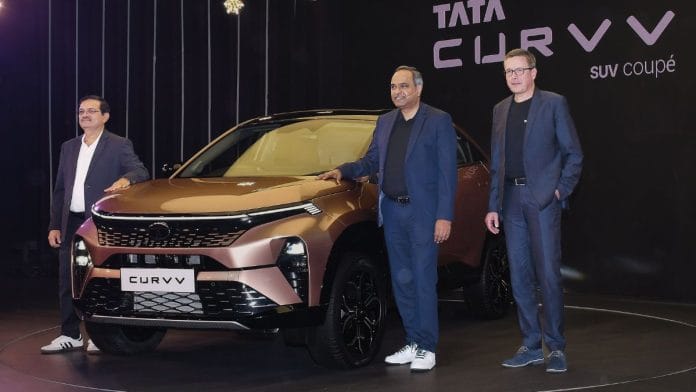It’s been three years since Tata Motors launched a new car. Their last launch—sub-compact SUV Punch—went on to become a best-seller. It’s only fair then for Tata Motors Managing Director, Shailesh Chandra to expect their latest offering, Tata Curvv, to also dominate the market.
Because, as he indicated when showcasing the car in Mumbai, Tata Motors’ Curvv has broken the affordability barrier when it comes to electric vehicles.
While there will be variants with petrol and diesel engines, only an electric option will be available when it is launched in September.
Priced between Rs 17.49 lakh and 21.99 lakh ex-showroom, Chandra pointed out that it was not just affordability on his mind. “It is also range anxiety, which is the main reason many people do not want to buy electrics. With the larger battery pack option on the Curvv (55 kilowatt-hours), we are saying that the vehicle will have a real-world range of around 400 kilometres. Our research has shown that most intercity drives are within this range.”
Also read: A day on test track with Narain Karthikeyan and Tata Altroz Racer—the newest hot hatch
Optimistic for growth
When the first concepts of this vehicle were shown, Tata Motors had indicated it would be an ‘electric-only’ platform. So what changed? “Just look at it, it is such a good-looking design. We felt it would be a travesty if people who still prefer internal combustion engines would be kept from enjoying this vehicle,” Chandra laughed.
He added that despite advancements in electric vehicle technology, there was still a large number of buyers who did not want to cross the ‘electric line’. “But while they look the same, the cars have different architectures, we developed an all-new ATLAS architecture for the Curvv and you will see that forthcoming models as well.”
And the gadgetification of cars will continue as well. “It is becoming seamless nowadays, your phone, your computer and your car,” Chandra said, but added that it is a longer conversation for another time.
Tata Motors, India’s third-largest carmaker, was one of the biggest beneficiaries of the post-Covid boom in car sales. Chandra attributes this to multiple factors, including excess disposable income among car buyers, and loss of trust in shared mobility taxi services and public transport. However, with growth in the automotive sector slowing to a trickle right now, is Chandra worried about the coming year?
“Look, the passenger vehicle market has grown from 2.7 million in 2021 (fiscal 2020-21) to 4.2 million in 2024 (fiscal 2023-24), which is an unprecedented growth of 50 per cent in three years. Usually, the car market grows in line with GDP. So, if we are seeing a decline in the rate of growth this year, we should not be surprised,” he said.
But he added that since all indicators for the economy are positive and monsoon sales have been good, they’re optimistic about maintaining last year’s numbers. “We may even grow a bit this year, particularly in the festive season coming up,” Chandra said.
Tata Motors does not share monthly production and domestic wholesale data with SIAM anymore but does give quarterly updates and in the first quarter of this fiscal year, wholesale numbers were stagnant.
Chandra dismissed wholesale numbers released by the industry body, the Society of Indian Automobile Manufacturers (SIAM). “We only look at registration data from the VAHAN portal (run by the Ministry of Road Transport and Highways) because that is ‘true’ retail data and we adjust our production accordingly because we do not want to create excess stock,” he noted.
In their July sales release, the Indian automotive dealers federation FADA claimed that stocks in excess of Rs 73,000 crore were lying unsold for the industry (this includes all types of vehicles including two-wheelers, tractors and commercial vehicles)
“Certain segments like hatchbacks (Tiago, Altroz) have been weak for us, but that is an industry-wide phenomenon,” said Chandra.
Chandra stated that Tata Motors’ market share at the retail level has remained steady for the past few months. He expects the Curvv, both the electric and ICE variants, to help Tata Motors in the coming quarters. “And we have a lot up our sleeves,” said Chandra hinting at a new petrol engine option for the Harrier and Safari early next year.
@kushanmitra is an automotive journalist based in New Delhi. Views are personal.
(Edited by Theres Sudeep)







Both ‘affordable’ housing and electric car are unaffordable in India.